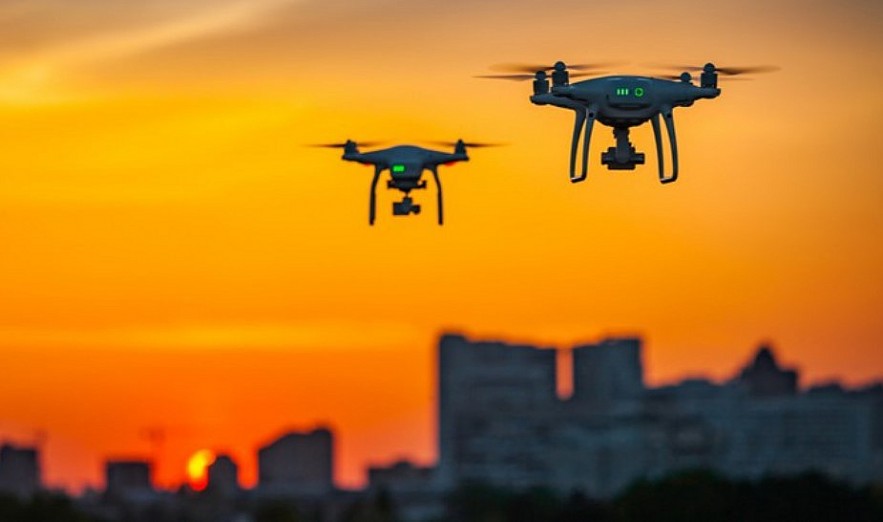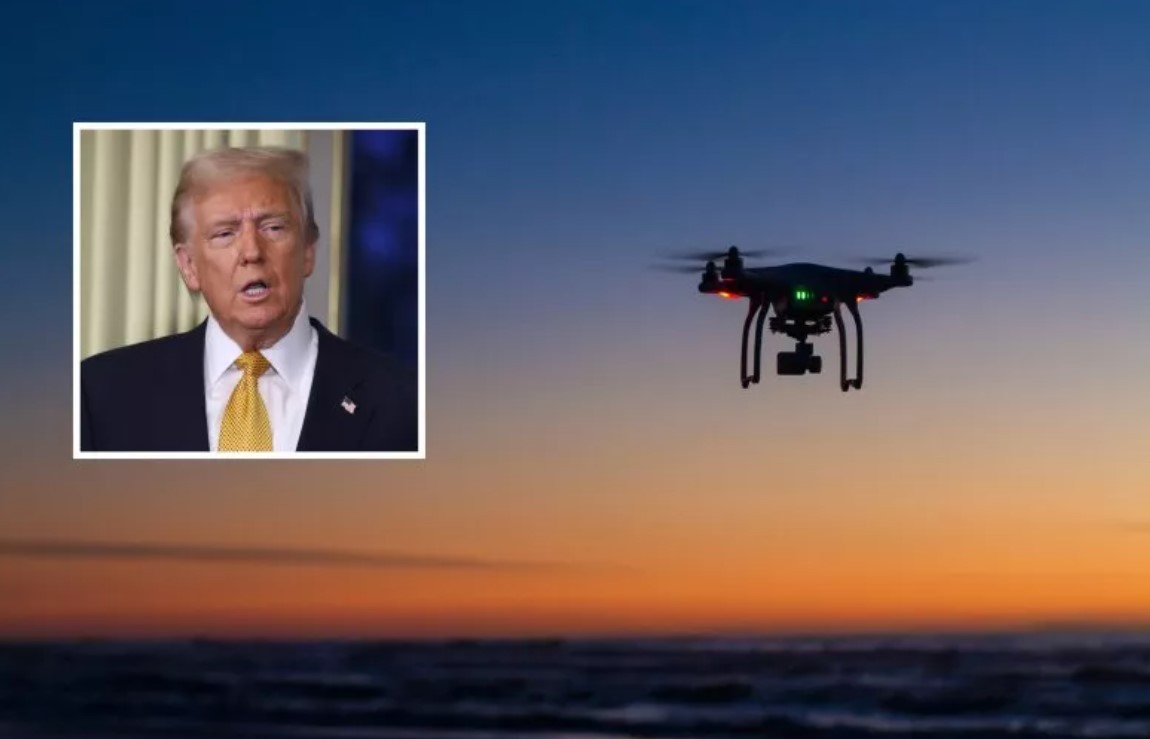How Many Drones Are Registered in the U.S.?
FAA Rule Change and Increased Drone Sightings“In September 2023, the FAA changed the rules to allow drones to fly at night,” Mayorkas explained. “That may be one of the reasons why people are now seeing more drones than they did before, especially during the hours from dusk to dawn.” |
Learn more: Reason for the Mysterious Drones: Rule Change by FAA
 |
| Drones by the Numbers |
Drones, or Unmanned Aerial Systems (UAS), have become an essential part of modern life in the United States, with uses ranging from recreational flying to professional applications in industries such as agriculture, real estate, and emergency response.
As of 2023, the Federal Aviation Administration (FAA) has implemented comprehensive regulations and guidelines to ensure the safe operation of drones across the country. In this article, we will explore the number of drones registered in the U.S., the FAA’s evolving regulations—especially regarding nighttime flights introduced in September 2023—and the geographical and legal boundaries for drone operations. Lastly, we will examine a recent surge in drone-related incidents in New Jersey and neighboring states, highlighting the challenges posed by increased drone activity.
Drone Registration Numbers in the U.S. (2024)
As of August 8, 2024, the Federal Aviation Administration (FAA) reported a total of 785,827 registered drones in the United States. This number reflects the extensive and growing use of drones across various sectors, including both recreational and commercial activities. Here's a breakdown of these registrations:
- Recreational Drone Registrations: 388,838 recreational drone pilots are registered under the FAA’s Exception for Limited Recreational Operations. Notably, this figure accounts for registered pilots, not individual drones. Many recreational pilots own multiple drones, meaning the actual number of recreational drones in use is likely much higher—potentially exceeding 800,000 drones.
- Commercial Drone Registrations: 390,027 drones have been registered for commercial purposes. This figure is expected to rise as Remote ID requirements mandate that commercial operators register each drone in their fleet individually.
Why the Numbers Are Significant
Recreational Drones:
- Recreational drone pilots typically register under a single number that applies to all drones in their inventory. This system means the 388,838 recreational pilot registrations may represent far more actual drones, given that many operators own multiple devices.
- Drones weighing under 250 grams (such as the DJI Mini 3 Pro and Autel Evo Nano) are exempt from registration unless used commercially. These lightweight drones add significantly to the unregistered recreational fleet.
Commercial Drones:
- With the introduction of Remote ID requirements (effective from September 16, 2023), commercial drone registration now operates differently. Each drone in a fleet must have an individual registration number, which reflects its built-in or standalone Remote ID module.
- Although the Remote ID rules were technically effective in September 2023, enforcement began on March 16, 2024, suggesting that the number of registered commercial drones will continue to increase as operators comply with the new requirements.
FAA Drone Regulations and September 2023 Updates
The FAA has been proactive in setting operational rules for drones to minimize risks to public safety and air traffic. These rules govern when, where, and how drones can be flown.
General Drone Operation Rules
- Daylight Operations: Previously, drones were restricted to daylight hours or civil twilight (30 minutes before sunrise and 30 minutes after sunset).
- Altitude Limits: Drones cannot exceed an altitude of 400 feet above ground level, unless flying near structures.
- Visual Line of Sight (VLOS): Operators must always keep the drone within their line of sight.
- Airspace Restrictions: Drones cannot operate in controlled airspace (e.g., near airports) without prior authorization through the Low Altitude Authorization and Notification Capability (LAANC) system.
Key Regulation Changes: Nighttime Operations
One of the most significant regulatory updates occurred in September 2023, when the FAA officially expanded permissions for nighttime drone operations. Previously, flying at night required a special waiver, but under the updated rules:
- Anti-Collision Lights: Drones flying at night must be equipped with lights visible for at least three statute miles.
- Remote ID Compliance: All drones must broadcast identifying information such as their location and operator details, enhancing accountability and safety.
- Part 107 Update: Commercial pilots operating under Part 107 no longer need a waiver for nighttime operations if they meet the new lighting and Remote ID requirements.
These updates reflect the FAA’s efforts to accommodate the growing needs of industries like delivery services, agriculture, and infrastructure inspection, which benefit from nighttime drone usage.
 Can I Shoot Down the Mysterious Drones Disrupting American Skies? Can I Shoot Down the Mysterious Drones Disrupting American Skies? |
Authorized Drone Flying Areas
The FAA has delineated areas where drones can and cannot operate to ensure safe integration into national airspace.
Permissible Areas
- Uncontrolled Airspace (Class G): Drones can operate freely in this airspace without requiring prior authorization.
- Designated Recreational Areas: Parks and open fields often allow recreational drone flying, provided local rules are followed.
- Authorized Controlled Airspace: Through LAANC, commercial drone operators can gain access to restricted airspace near airports during specified times.
Restricted Areas
- Prohibited Zones: These include areas such as military installations, national parks, and designated security areas like the White House and government buildings.
- Temporary Flight Restrictions (TFRs): During events such as natural disasters or presidential visits, the FAA imposes TFRs to restrict drone activity.
- Populated Areas: Operating drones over groups of people is prohibited unless the drone meets specific safety standards.
Local governments may also impose additional restrictions on drone usage, requiring operators to familiarize themselves with state and municipal laws.
Recent Drone Incidents in New Jersey and Neighboring States
The surge in drone usage has not been without complications. Recent incidents in New Jersey and surrounding states illustrate the challenges posed by both recreational and unauthorized drone operations.
Incident Overview
In early 2023, a series of drone sightings near Newark Liberty International Airport caused temporary flight disruptions. These drones were reportedly flying within controlled airspace without FAA authorization, raising serious safety concerns. The incidents prompted an investigation by federal authorities and highlighted the need for stricter enforcement of airspace regulations.
Neighboring State Issues
Similar incidents have been reported in New York, Pennsylvania, and Connecticut, where drones have been spotted near critical infrastructure, including bridges and power plants. In some cases, drones have been used for illegal activities, such as smuggling contraband into prisons, further complicating regulatory efforts.
Balancing Innovation and SafetyWhile drones offer immense benefits, their rapid proliferation presents regulatory challenges. The FAA’s emphasis on Remote ID technology and stricter penalties for unauthorized operations aims to strike a balance between fostering innovation and ensuring public safety. At the same time, states like New Jersey are collaborating with federal authorities to implement drone detection systems near critical infrastructure to mitigate risks. |
Conclusion
Drones have become a transformative technology, offering unparalleled convenience and efficiency in various fields. With over 1 million drones registered in the U.S., the FAA continues to adapt its regulations to accommodate growing demand while maintaining safety and security. The recent September 2023 updates to nighttime flying rules reflect this evolving approach. However, incidents in New Jersey and neighboring states underscore the challenges that come with increased drone activity. Moving forward, collaboration between federal agencies, state governments, and drone operators will be crucial to ensuring the safe and responsible integration of drones into American airspace.
FAQs
1. How many drones are currently registered in the United States?
As of 2023, over 1.8 million drones are registered with the FAA. This includes approximately 1.3 million recreational drones and 500,000 drones for commercial use.
2. Is it mandatory to register my drone?
Yes, registration is mandatory for all drones weighing between 0.55 pounds (250 grams) and 55 pounds (25 kilograms). Recreational users must register their drones under the FAA's guidelines, and commercial operators must register under Part 107.
3. What are the new FAA rules for nighttime drone operations?
As of September 2023, drones are allowed to fly at night without requiring a special waiver, provided they:
- Are equipped with anti-collision lights visible for at least three statute miles.
- Comply with the Remote ID requirement, which broadcasts the drone's identification and location.
4. Where can I fly my drone legally?
You can fly drones in:
- Uncontrolled airspace (Class G) without authorization.
- Designated recreational areas like parks and open fields, depending on local rules.
- Controlled airspace with LAANC authorization, especially near airports.
Drones are prohibited from flying in national parks, military installations, restricted airspace, and over populated areas unless specific permissions are granted.
5. Can drones be flown near airports?
Drones are not allowed to fly near airports unless the operator has received prior authorization through the LAANC system. Unauthorized flights in controlled airspace can result in fines or criminal penalties.
6. What is Remote ID, and why is it important?
Remote ID is a technology that allows drones to broadcast their location, identification, and operator details. It helps:
- Improve airspace safety.
- Assist law enforcement in identifying unauthorized flights.
- Enable safe integration of drones into national airspace.
7. What are the penalties for violating FAA drone regulations?
Violating FAA rules can result in fines ranging from $1,000 for recreational violations to $27,500 for civil penalties. Criminal violations may lead to additional penalties, including imprisonment.
8. What should I do if I encounter a suspicious drone?
If you spot a drone engaging in potentially dangerous or unauthorized activity:
- Contact local law enforcement.
- Report the incident to the FAA’s DroneZone website.
- Avoid interfering with the drone directly.
9. What are the common issues related to drones in New Jersey and nearby states?
Recent issues include:
- Unauthorized flights near airports, such as those near Newark Liberty International Airport.
- Illegal activities, like smuggling contraband into prisons.
- Safety concerns around critical infrastructure, including bridges and power plants.
These incidents highlight the importance of stricter enforcement and new detection technologies.
10. How can I get certified as a commercial drone pilot?
To become a certified commercial drone pilot:
- Pass the FAA's Part 107 Knowledge Test, which covers topics like airspace regulations, weather, and safety.
- Register your drone under the FAA’s commercial category.
- Renew your certification every 24 months by passing a recurrent knowledge test.
11. Can I fly my drone over people?
Flying over people is generally prohibited unless:
- The drone meets strict safety standards (e.g., Category 1, 2, or 3 drones defined by the FAA).
- The operation is part of an FAA-authorized activity, such as a certified public event.
12. Are there new technologies to manage drone safety in high-traffic areas?
Yes, technologies such as:
- Drone detection systems to monitor unauthorized flights.
- Geo-fencing to prevent drones from entering restricted airspace.
- Remote ID systems for identifying drones in real-time.
 Fact-Check: Shooting Down the Mysterious Drones in New Jersey Fact-Check: Shooting Down the Mysterious Drones in New Jersey A video surfaced on Friday evening allegedly showing people in New Jersey shooting down some of the mysterious drones that have been sighted in the ... |
 What Is the Origin of the Drones Over U.S. Skies? Investigation Limits and the Military Perspective What Is the Origin of the Drones Over U.S. Skies? Investigation Limits and the Military Perspective This article examines the current state of investigations into these mysterious drones, the challenges facing law enforcement and the military, and what this phenomenon means ... |
 Mysterious Drones in the U.S: Security risks, Legal loopholes, and Media controversy Mysterious Drones in the U.S: Security risks, Legal loopholes, and Media controversy The appearance of unidentified drones in U.S. airspace has sparked national security concerns. |
 Fact-Check: Pentagon Confirm 'Drones Not Of Earthly Origin' (UFOs) Fact-Check: Pentagon Confirm 'Drones Not Of Earthly Origin' (UFOs) The Pentagon reportedly confirmed that mysterious drones around the world are "not human," according to a widely shared social media post, but the video offered ... |


























